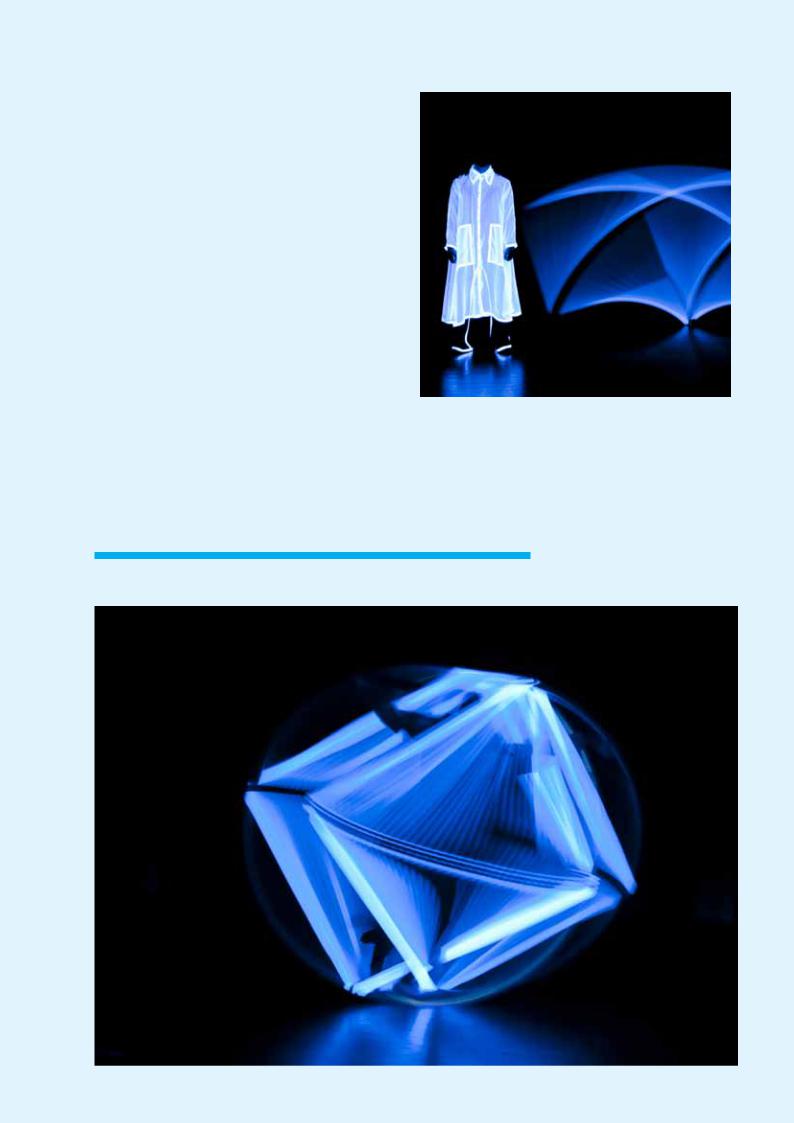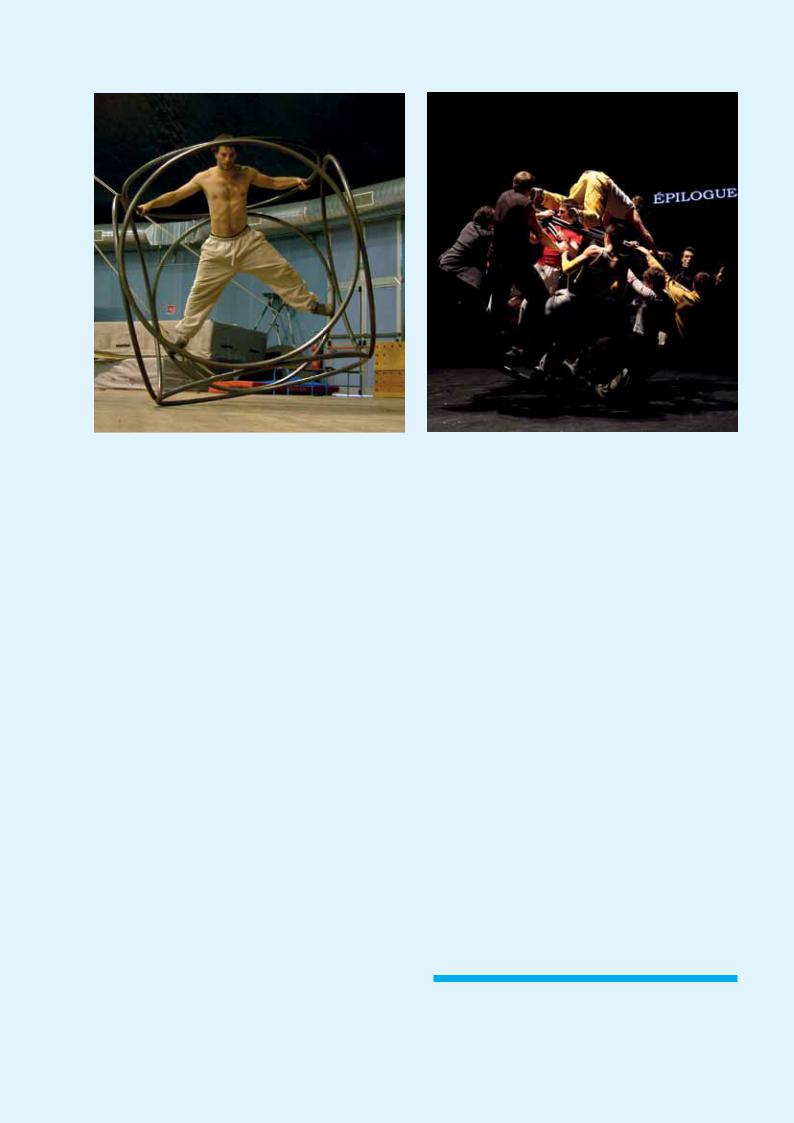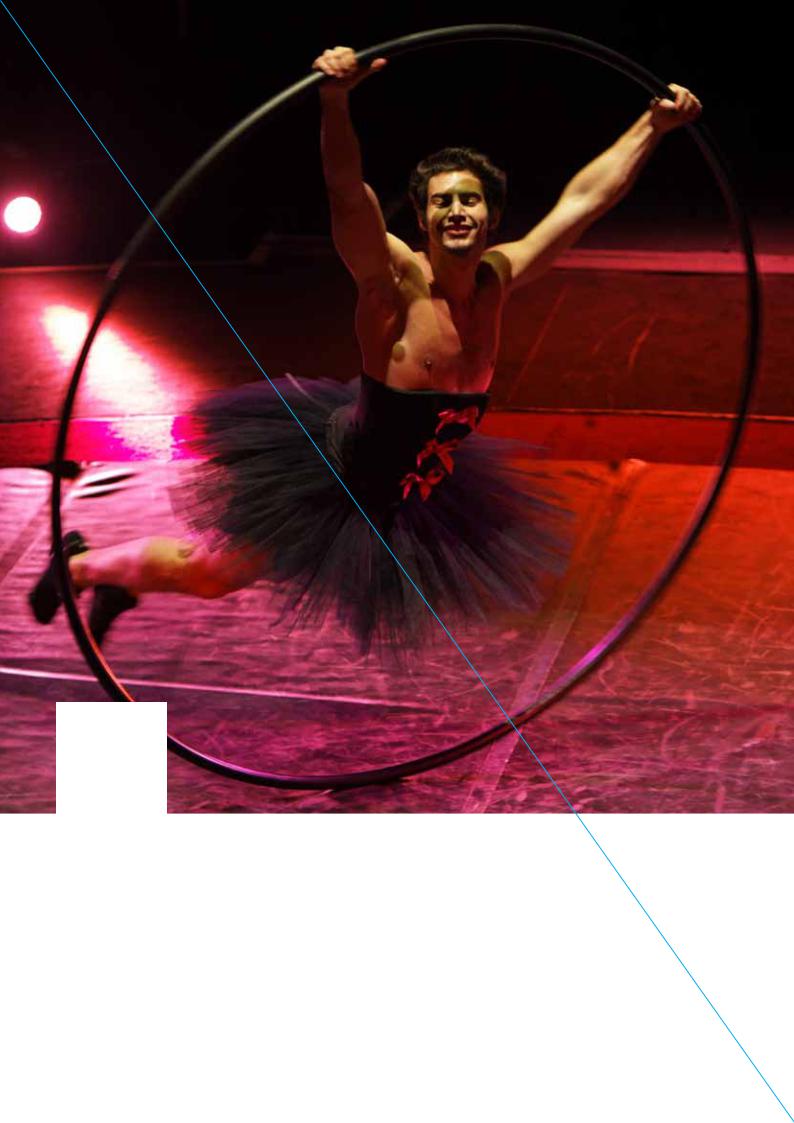
fedec_cyrwheelmanual_en_2011
.pdf
Identifying potential injury areas
The highest rate of pain/injuries on the Cyr wheel affects the shoulder girdle. The development of shoulder muscle strength and endurance must be emphasised - both agonistic and stabilising muscles, as they are the catalysts of movement. As an example, Exercises such as shoulder développés, simple and complex external rotation exercises should be included in the training programme.
Strengthening/stabilising exercises for both ankle and wrist could be advisable for students with weaknesses or instabilities in these areas.
Students ‘recurring discomfort or pain when performing certain moves, teachers’ remarks on compensating movements and the physiotherapist’s initial assessment will also determine which exercises must be added for injury prevention.
Identifying the antagonistic muscles in main movements
In order to maintain a muscular balance which is healthy for joint integrity, muscles that are antagonistic to main movements also need to be trained. For example, if one or more trunk flexing exercises (abdominals, front/side planks) are part of a training programme, one or more trunk extension exercises (latissimus dorsi, cradle…) should also be included in the programme.
Finally, at the end of a training session, stretching the areas of the body which are put under the most strain will help students to minimise the risk of traumatic injuries in the longer term.
© fedec 2011 |
CYR WHEEL 49 |

07
Research
and innovation
50 CYR WHEEL |
© fedec 2011 |

The high physical demands placed on the body of the circus artist provide a multitude of
rich emotions which can be exploited artistically.
In order to find the correct artistic engagement, it is necessary to nurture the connections between the body and the environment which are the driving forces of the way we are.
More generally speaking, the live performance can only “exist” through the relation with others and with the environment in which the artist evolves. The truth is in the tangible perception of the elements which make up a simple movement and its resonances. The space, aerial rigging and the directional intention of movement reinforce the artists’ self-awareness and their awareness of the environment and the performance space where they evolve.
However, similarly to the psychomotor development of children which occurs in the playground, the creativity of the circus artist is strongly linked to concrete elements and to the exploration of the performance space, in the shape of equipment or scenography.
The debate is still open on when to introduce a new piece of apparatus. Some think that training a specific discipline or piece of apparatus is necessary throughout the academic course in order to perfect the technique and that it is best to wait until after the course to embark on such an enterprise. Others think differently and would be more daring.
G. Fasoli
© fedec 2011 |
CYR WHEEL 51 |

01
DEMAIN LE CIRQUE
New pieces of apparatus for circus artists A collaboration that makes reciprocal sense
An example of a collaboration between two institutes of higher artistic education: the Ecole Supérieure des Arts du Cirque (Belgium) and Ecole Nationale Supérieure des Arts Visuels La Cambre
After the first collaboration between ESAC and La Cambre (which in 2010 led to defining a new graphic identity for the Institute of Higher Artistic Education in Circus Arts), the two institutes chose to continue these pedagogic and artistic collaborations through a research project on new circus apparatus.
If such collaborations are proof of the favourable environment provided by the Brussels Region in terms of an artistic melting pot, they also have the advantage of promoting quality in artistic teaching in Belgium, allowing the sharing of knowledge and to engage in debates for students. An enriching experience that Gérard Fasoli, the
ESAC director and Caroline Mierop, La Cambre’s director wished to enhance.
The Industrial Design Option department in La Cambre has worked with some students and teachers at ESAC to deal, first of all, with movement and space management. Contemporary circus equipment was then reinterpreted creatively, with the idea of going beyond the constraints of space and of the body within it.
Gérard Fasoli was invited to present the project to La Cambre students in November 2010. Research and prototypes have been supervised by La Cambre’s professors, especially Marion Beernaerts (workshop leader) and Giampiero Adelmo Pitisci. Students from the two institutes met up on several occasions and then went on to create smaller working groups to pursue a specific research project related to Cyr wheel and ladder techniques.
52 CYR WHEEL |
© fedec 2011 |

The industrial designer training at La Cambre hinges on a certain number of exercises which plunge students into reality with all its limits and with the need to provide a solution which satisfies and, at the same time, exceeds initial expectations. The proposal formulated by the ESAC satisfied perfectly this pedagogic and artistic necessity.
The industrial design conceptual activities within the High School of La Cambre intend to determine the formal properties of objects that one wishes to produce industrially. By «formal properties», we mean the external characteristics and structural relations which make an object or a series of object a coherent unit, from both the user and the maker’s point of view. This discipline clarifies the mixing of interactions between collective aspirations, technical progress, social and economic context and development of the arts.
Industrial design studies have the ambition of conveying knowledge and methodologies which can reveal powerful and unexpected artistic personalities, capable of innovating from both the form and technological point of view, of integrating new sociological challenges and meeting different parties in industrial production, whilst always considering notions of ethics and meaning.
The lessons are given by a team of teachers which are all active professionals in the industrial design sector. The complementarity of talks and subjects taught adds value to the whole training process at the La Cambre School.
A few months later, La Cambre students have presented 8 prototypes, created with the support of the French Community Commission.
An exhibition of each new piece of equipment and a short demonstration by ESAC students from each of the 3 year groups took place in La Cambre School on the 27th May 2011, in the presence of the pedagogic, cultural, artistic and administrative project stakeholders.
Encouraging the meeting of different artistic sensitivities from different backgrounds will allow us to achieve the best results in our research
on tools we work with.
The meeting between a technician and a circus artist is good, but one between an artist technician and
a circus artist is even more fruitful.
Gérard Fasoli urges participants to approach similar institutes in their countries of origin. Encouraging the meeting of different artistic sensitivities from different backgrounds will allow us to achieve the best results in our research on tools we work with.
The meeting between a technician and a circus artist is good, but one between an artist technician and a circus artist is even more fruitful.
More info on: http://www.youtube.com/watch?v=WHiQkf2ndDQ http://w w w.fedec.eu/datas/files/esac _ projet _ demain_le_cirque_20110616.pdf
For all questions related to the reproduction of works displayed and which are subject to copyright, please contact Professor Marion Beernaerts, Industrial Design Option, at the Institute of Higher Education of Visual Arts La Cambre : www.lacambre.be
© fedec 2011 |
CYR WHEEL 53 |

02
JUHO SARNO AND QUANTUM CIRCUS :
Using lights to make impossible look possible
When we started working on the Cyr wheel scene,
the Director gave us a mission “ make impossible look possible”. We came up with the idea of a square moving like a wheel, creating impossible movement.
This we did with UV-light, hiding the wheel into blackness, and creating a square with a white textile connecting it from corners to the wheel.
It was a great idea and we got what we were looking for, square rolling and twisting and waltzing.
But we also got something else, by following the movement of the Cyr-Square, we could clearly see the regularity of the basic movements of the Cyr, in basic step, we could easily make the corners of the square hit the floor equally, like the square would have been stepping
54 CYR WHEEL
from one corner to the other. For me it helped to understand the importance of regularity and rhythm in Cyr wheel technique.
Our first idea was to work with two Cyr Squares, but after some time I decided to take the other one out, instead we clad the other performer in white transparent coat, and found another beautiful image, floating performer.
Seeing a Cyr wheel performance is quite beautiful and magical by itself, movement is fluid and light, but seeing the movement of the performer without the wheel was even stronger image.
© fedec 2011

We combined these two elements, Cyr-square and floating performer and created the peace out of these two elements. We used quite simple techniques and wheel manipulations to achieve our goal. It came out to be a nice piece with humour and magical atmosphere.
Now, I know that black theatre and UV-light is nothing new, but combining it with Cyr wheel gave us something beautiful and new. And even more important, it can be developed a lot further than we did! I’ve already dreamed of using white rubber band for the square, creating three dimensional figures while spinning.
Juho Sarno
We combined these two elements, Cyr-square and floating performer and created the peace out of these two elements. We used quite simple techniques and wheel manipulations to achieve our goal. It came out to be a nice piece with humour and magical atmosphere.
© fedec 2011 |
CYR WHEEL 55 |

03
The “Cube”
Rémy Bénard is a Cyr wheel and German wheel specialist who trained at the National Centre for Circus Arts (CNAC). He reflected on the shape of
the wheel, and decided to explore its variations. He believes in acrobatic potential and the possibility of manipulating these shapes. Together with the workshop
in charge of devising and making pieces of apparatus in the school, they agreed to try and build a new structure: the cube.
It is always difficult to evaluate the potential of an apparatus in advance. The construction of prototypes was therefore essential whereby different shapes could be tested. Following this first stage it was determined that every object moved on a trajectory which was determined by its shape. These prototypes enabled the team to explore the possibility of movement, on a reduced scale, to inform their choices before moving into the construction phase.
56 CYR WHEEL
Before constructing the piece of apparatus, it was necessary to plan an acrobatic piece in order to better calculate the forces exerted and resistances necessary. The main difficulty was finding the balance between the weight of the object and its robustness. Once finalised, the apparatus had to be robust enough in order to be used for acrobatic work but also light enough to be manipulated. In order to transfer the technical skills used in Cyr wheel and German wheel, the new objects had to abide by
© fedec 2011

the same fundamental principles, i.e. being of a dimension similar to that of a human and being made of round, curved metallic tubes. Another important aspect was the constraint imposed by the itinerant nature of the circus artist’s profession; in order to facilitate transport, the apparatus had to be easy to take apart and reassemble.
It was impossible to construct all the shapes desired, therefore Remy created the cube. Other pieces of apparatus had emerged from this research, namely a spiral with Benoît Fauchier. The cube was formed by 6 metallic hoops, whose dimensions were determined by the diagonal of the cube. It was mainly through this diagonal that the Cyr wheel technique could be used. Today Rémy Bénard continues to explore the cube and the paradox offered by this shape (a round cube? a squared circle?) and the possibilities it could have for collective works.
It was experienced with “Urban Rabbits”, CNAC’s 21st cohort end of studies show which toured in 2009/2010. During this show, 16 finishing students gathered on the cube.
The training period at CNAC was essential in order to initiate research, but clearly not long enough to complete it in full.
Using the Cyr wheel and German wheel techniques has provided a clear advantage when practising with these customised pieces of apparatus, as a good mastery of similar pieces of apparatus enables the performer to explore more quickly, deeply and calmly.
On a pedagogic level, it can be difficult for a school to support this sort of innovation. It can offer support through an explorative method (conceptualisation, relationship between the object and its public, reflection on shape and its representations) instead of a learning method which cannot exist without established conventions.
Today Rémy Bénard continues to nourish his reflection on these questions through the several projects he takes part in, namely “Kosm, ballet manipulatoire pour cercle et corps” (temporary title), a show by the La tournoyante company, a collective of manipulators-wheel acrobats and “Tube”, a show by the Mauvais Esprits company, where he uses Benoît Fauchier’s work on the spiral.
The cube was formed by 6 metallic hoops, whose dimensions were determined by the diagonal of the cube. It was mainly through this diagonal that the Cyr wheel technique could be used.
© fedec 2011 |
CYR WHEEL 57 |

08
GLOSSARY OF TERMS
58 CYR WHEEL |
© fedec 2011 |
